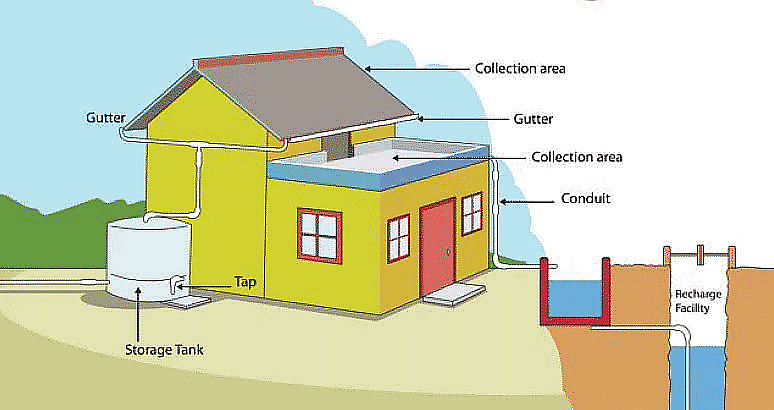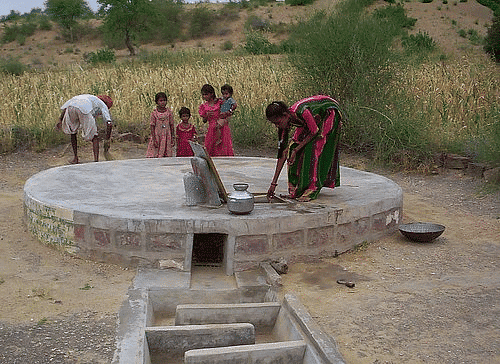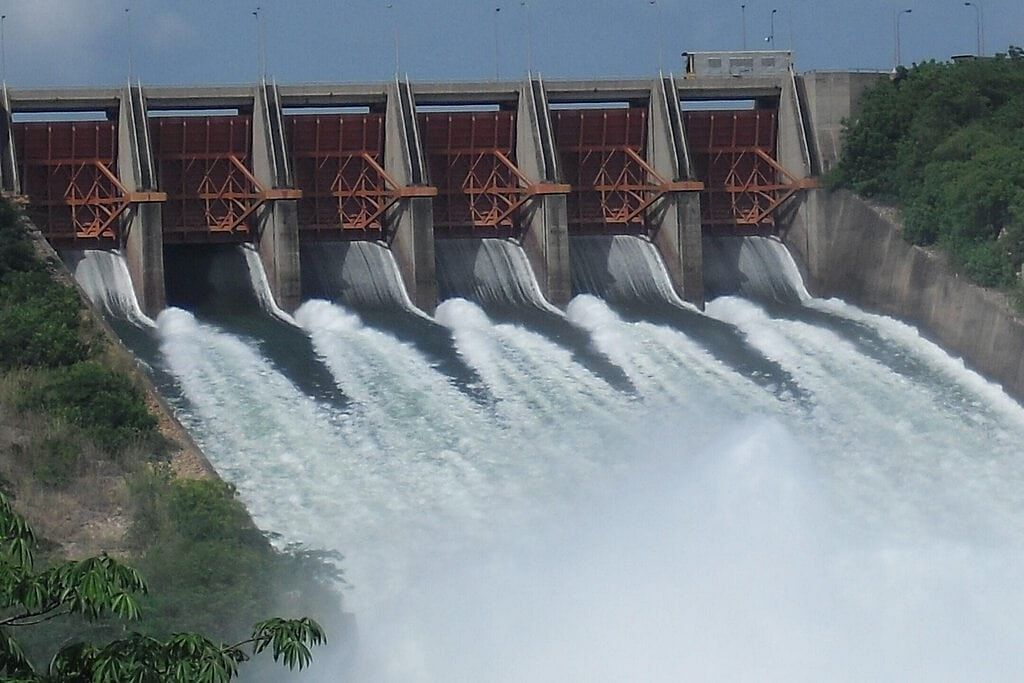Class 10 Geography Chapter 3 Extra Question Answers - Water Resources
Q1: What is rainwater harvesting? Explain any two different methods of rainwater harvesting in different regions of India.
Ans: Rainwater harvesting is a system in which rain water is collected through various techniques and then collected water is used in many ways.
(i) Hill region - In hilly region people built diversion channels like the ‘‘guls’’ or ‘‘kuls’’ in the western Himalayas for agriculture. With these channel rainwater is used in meaningful ways.
(ii) Arid region - In Rajasthan almost all houses had underground tanks. These tanks were part of well developed rooftop rainwater harvesting system. They were connected to the sloping roof of the houses through a pipe. Rain falling on the rooftops would travel down the pipe and get stored in these underground ‘tankas’.
Q2: What is a multipurpose river valley project? Give any four objectives of the multipurpose river valley project.
Ans: The multipurpose river valley project is a river project in which a dam is constructed on the river and stored water is then used in a number of for like irrigation, power generation etc.
Four objectives of multipurpose projects are :—
(i) To check floods by regulating flow of water.
(ii) To generate hydro power for our industries and homes.
(iii) To provide irrigation facilities. This helps in increasing agriculture productivity and bringing more area under cultivation.
(iv) To check soil Erosion.
Q3: Discuss how rainwater harvesting in semi-arid regions of Rajasthan is carried out.
Ans: Rain water harvesting in semi-arid region of Rajasthan is carried out in the following ways :-
- In Bikaner, Phalodi and Barmer, almost all the houses traditionally had underground tanks or ‘‘tankas’’ for storing drinking water.
- The tanks could be as large as a big room; one household in Phalodi had a tank that was 6.1 metres deep, 4.27 metres long and 2.44 metres wide.
- The tankas were part of the well developed rooftop rainwater harvesting system and were built inside the main house or the courtyard.
- They were connected to the sloping roofs of the houses through a pipe.
- Rain falling on the rooftops would travel down the pipe and was stored in these underground ‘tankas’.
Q4: Describe three traditional methods of rainwater harvesting practised in India.
Ans: In India traditionally rainwater harvesting is done in the following ways :—
(i) In hilly regions people built diversion channels like the guls or kuls for agriculture.
(ii) In Rajasthan rooftop rainwater harvesting is practised.
(iii) In Bengal people built inundation channels to irrigate their fields.
(iv) In arid and semi-arid regions people convert their agricultural fields into rainfed storage structures.
Q5: Give three reasons for water scarcity in post-independence India.
Ans: Three reasons for water scarcity in India are :–
(i) Post-independance India has witnessed intensive industrialisation and urbanisation which increased water demand.
(ii) Large urban centres with large and dense population and urban lifestyles have only added to water requirement.
(iii) Population explosion after independence led to overexploitation of underground water for irrigation.
Q6: ‘Three-fourths of the earth’s surface is covered with water but there is still scarcity of water across the globe.’ Explain giving three reasons.
Ans: Water scarcity is due to the following causes :—
(i) Water availability varies over space and time mainly due to the variation in seasonal and annual precipitation.
(ii) Rapid urbanisation is another factor for water scarcity.
(iii) Rapid increase in population that demand more and more water.
(iv) Industrialisation is another cause, large industrial houses are using more and more water, they also require more water to generate electricity.
(v) Rising income levels also create more demand for water.
(vi) 96.5 per cent of the total volume of world’s water is estimated to exist as oceans and only 2.5 per cent as fresh water. Nearly 70 per cent of this freshwater occurs as ice sheets and glaciers, while a little less than 30 per cent is stored as groundwater in the world’s aquifers.
Q7: How have industrialisation and urbanisation aggravated water scarcity in India?
Ans: Industrialisation and urbanisation have aggravated water scarcity in India in the following ways:
(i) Large industrial houses are exerting pressure on existing freshwater resources. Industries apart from being heavy user of water also require water power to run them.
(ii) Multiplying urban centre with large and dense population and urban lifestyles have not only added to water and energy requirement but further aggravated the problems. Water resources are being over-exploited.
Q8: Why is the conservation and management of water resources important? Give any three reasons.
OR
Why is there an urgent need to conserve and manage our water resources? Give three reasons.
Ans: The conservation and proper management of water is necessary because of following reasons:
(i) Growing population :- As population is growing its need for water is also growing, so it is necessary to properly manage the availability of water.
(ii) Increasing Urbanisation :- More and more people are moving to cities where need of water is growing. On the other hand, cities are overexploiting and polluting water resources, so there is need to conserve water.
(iii) Due to industrialisation also water is being overexploited. So, without proper conservation it would be difficult to survive.
Q9: Explain any three disadvantages of multipurpose projects.
Ans: Three disadvantages of multipurpose projects are :
(i) A large area is submerged with water causing destruction of wildlife and forests.
(ii) A large number of people living in the affected areas are displaced, so their rehabilitation remains a problem.
(iii) Aquatic life and natural course of rivers get affected. Multipurpose projects had to destruction of flora and fauna.
Q10: Why are different water harvesting systems considered a viable alternative both socio - economically and environmentally in a country like India?
Ans: No single method can be applicable everywhere. It is true in case of rain water harvesting system too, as geographically there are different regions. Different regions have different methods.
(i) In Hilly region :- Through kuls or guls it is very easy to divert water for irrigation. It is a low cost method.
(ii) In Arid region :- Like in Rajasthan rainwater is collected on roofs, then piped into ground storage system. That method is also economical, needing no extra effort.
(iii) In villages agricultural fields are converted into ponds where rainwater is collected. All these methods are very easy and viable.
Q11: How far have the multipurpose projects been able to achieve their purpose for which they were made? Explain.
Ans: To some extent multipurpose river valley projects have been able to achieve their purpose. Irrigation has increased, power generation is a classic example of their success. But there are some concerns too.
- They have obstructed the natural flow of rivers causing destruction of habitat aquatic life.
- People have also been affected as their habitat too have been submerged. It leads to socioeconomic proplems of big magnitude as lakhs of people are displaced.
- This has led to huge destruction of flora and fauna, forests and biodiversity.
Q12: Why is the need for water increasing day by day? Explain three reasons.
Ans:
(i) Rapid industrialisation and urbanization have led to greater demand for water. Industries need water for various purposes.
(ii) Large population means more water is needed for domestic use and for agriculture to produce more food.
(iii) Multiplying urban centres with large and dense population and urban life-styles have led to greater need for water.
Q13: Give an account of any three hydraulic structures of ancient India.
Ans:
(i) During the period of Chandragupta Maurya - dams, lakes and irrigation systems were extensively built.
(ii) In the 11th century, Bhopal lake, one of the largest artificial lakes of its time was built.
(iii) In the first century B.C. Sringaverpur near Allahabad had large and complex water harvesting system chenneling the water of the Ganga.
Q14: ‘Large multi-purpose projects also lead to land degradation.’ Explain.
Ans: Regulating and damaging of rivers affect their natural flow causing poor sediment flow and excessive sedimentation at the bottom of reservoir. Large reservoirs submerge large tracts of forests, flora and fauna. They also submerge soil leading to its decomposition over a period of time.
Q15: What is a dam? How are dams classified?
Ans: A dam is a barrier across flowing water that obstructs, directs or retards the flow, often creating a reservoir, lake or impoundment.
- Dams refer to the reservoir rather then the structure.
- Dams are classified according to structure, intended purpose or height.
- Based on structure and the materials used, dams are classified as timber dams, embankment dams or masonry dams, with several subtypes.
- According to the height, dams are classified as large dams and major dams or alternatively as low dams, medium height dams and high dams.
Long Answer Type Questions
Q1: How was water conserved in ancient India? Give any four examples in support of your answer.
Ans: Archaeological and historical records show that from ancient times people have been constructing sophisticated hydraulic structures like dams built of stone rubble, reservoirs or lakes, embankments and canals for irrigation. This tradition is being followed in modern India too. People are building dams in most of the river basins.
Four examples to show how water was conserved in ancient India-
(i) In the first century BC, Sringaverapura near Allahabad had sophisticated water harvesting system channelling the flood water of the river Ganga.
(ii) During the time of Chandragupta Maurya, dams, lakes and irrigation systems were extensively built.
(iii) Evidences of sophisticated irrigation works have also been found in Kalinga (Odisha), Nagarjunakonda (Andhra Pradesh), Bennur (Karnataka), Kolhapur (Maharashtra), etc.
(iv) In the fourteenth century, the tank in Hauz Khas, Delhi was constructed by Iltutmish for supply-ing water to Siri Fort area.
Q2: “In recent years, the multi-purpose projects and large dams have come under great scrutiny.” Give reasons.
Ans: In recent years, multi-purpose projects and large dams have faced opposition for a variety of reasons-
(i) Regulating and damming of rivers affect their natural flow causing poor sediment flow and excessive sedimentation at the bottom of the reservoir, resulting in rockier stream beds and poorer habitats for the rivers’ aquatic life.
(ii) Dams also fragment rivers making it difficult for aquatic fauna to migrate, especially for spawning.
(iii) The reservoirs that are created on the floodplains also submerge the existing vegetation and soil leading to its decomposition over a period of time.
(iv) Multi-purpose projects and large dams cause large-scale displacement of local communities. Local people are forced to give up their land, livelihood and their meagre access and control over resources. As a result, they face hardships. On the other hand, the landowners, and large farmers, industrialists, etc. are benefited.
(v) Dams not only increase social gap between the richer landowners and the landless poor but also. create conflicts between people wanting different uses and benefits from the same water resources. For example, in Gujarat, the Sabarmati-basin farmers are agitated and almost caused a riot over the higher priority given to water supply in urban areas, particularly during draughts.
(vi) Irrigation has also changed the cropping pattern of many regions with farmers shifting to water intensive and commercial crops. This has great ecological consequences like salinisation of the soil.
Q3: Explain the ecological problems being faced due to the multi-purpose river projects.
Ans: In recent years, multi-purpose projects and large dams have faced opposition for a variety of reasons-
(i) Regulating and damming of rivers affect their natural flow causing poor sediment flow and excessive sedimentation at the bottom of the reservoir, resulting in rockier stream beds and poorer habitats for the rivers’ aquatic life.
(ii) Dams also fragment rivers making it difficult for aquatic fauna to migrate, especially for spawning.
(iii) The reservoirs that are created on the floodplains also submerge the existing vegetation and soil leading to its decomposition over a period of time.
(iv) Multi-purpose projects and large dams cause large-scale displacement of local communities. Local people are forced to give up their land, livelihood and their meagre access and control over resources. As a result, they face hardships. On the other hand, the landowners, and large farmers, industrialists, etc. are benefited.
(v) Dams not only increase social gap between the richer landowners and the landless poor but also . create conflicts between people wanting different uses and benefits from the same water resources. For example, in Gujarat, the Sabarmati-basin farmers are agitated and almost caused a riot over the higher priority given to water supply in urban areas, particularly during draughts.
(vi) Irrigation has also changed the cropping pattern of many regions with farmers shifting to water intensive and commercial crops. This has great ecological consequences like salinisation of the soil.
Q4: Write the features of the tankas built in the houses of Bikaner, Phalodi and Banner.
Ans:
(i) The tankas or tanks are found in the semi-arid and arid regions of Rajasthan, particularly, in Bikaner, Phalodi and Barmer. They are built underground to store drinking water.
(ii) These tankas are as large as a big room. One household in Phalodi has a tanka that is 6.1 metres deep, 4.27 metres long and 2.44 metres wide.
(iii) The tankas are part of the well-developed rooftop rainwater harvesting system and are built inside the main house or the courtyard.
(iv) They are connected to the sloping roofs of the houses through a pipe. Rain falling on the rooftops travels down the pipe and is stored in these underground tankas.
Q5: Why is rooftop rainwater harvesting important in Rajasthan? Explain.
Ans:
(i) Rajasthan is a desert region which receives scanty rainfall. Most of it falls during the rainy season from June to September, leaving the soil to parch the rest of the year.
(ii) Most of the wells in Rajasthan have gone dry and people face acute water crisis.
(iii) People in Rajasthan have, therefore, built underground tankas or tanks to store water. Almost all the houses traditionally have these tankas that serve great purposes.
(iv) These tankas are part of the well-developed rooftop rainwater harvesting system. The rainwater stored in these tankas is an extremely reliable source of drinking water when all other sources are dried up, particularly in the summers.
(v) Rainwater is considered the purest form of natural water. As there is lack of perennial rivers in Rajasthan, people heavily depend on rainwater.
(vi) Rooftop rainwater harvesting is important in Rajasthan also for the reason that it is used to beat the summer heat as it keeps the room cool and comfortable.
|
63 videos|445 docs|87 tests
|
FAQs on Class 10 Geography Chapter 3 Extra Question Answers - Water Resources
| 1. What are the different sources of water? |  |
| 2. What are the different uses of water? |  |
| 3. What is the importance of water conservation? |  |
| 4. What are the methods of water conservation? |  |
| 5. How can individuals contribute to water conservation? |  |

|
Explore Courses for Class 10 exam
|

|
 (i) Hill region - In hilly region people built diversion channels like the ‘‘guls’’ or ‘‘kuls’’ in the western Himalayas for agriculture. With these channel rainwater is used in meaningful ways.
(i) Hill region - In hilly region people built diversion channels like the ‘‘guls’’ or ‘‘kuls’’ in the western Himalayas for agriculture. With these channel rainwater is used in meaningful ways.



















